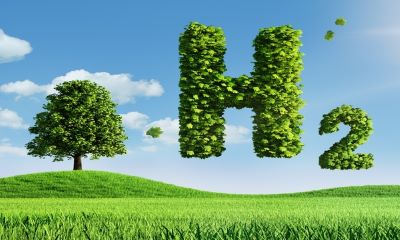If planned projects are commissioned by 2026, China, Chile, Spain, and Australia could together bring 85% of the additional 18 GW of renewable capacity

Large projects (10-100 MW) are expected to bring almost 18 GW of additional renewable capacity during the period of 2021-2026 dedicated to the production of hydrogen or ammonia from renewables as per International Energy Agency (IEA) report.
IEA’s ‘Renewables 2021-Analysis & Forecast to 2026’ cites policy momentum supporting the production of hydrogen from renewables and biojet as key drivers for a large number of projects. The planned project pipelines in almost 30 countries, as per report, indicate that global electrolyzer capacity for hydrogen could stimulate the deployment of 18 GW of additional wind and solar PV capacity in the 2021-2026 period.
While this would account for only 1% of forecast growth of renewables in IEA's main case, the fulfillment of the entire announced electrolyzer capacity pipeline could bring an additional 475 GW of wind and solar PV capacity in the longer term, the equivalent of one-third of total installed variable renewable capacity today, dedicated mostly to green hydrogen production. The majority of planned projects consider hybrid wind, solar PV and battery storage plants for hydrogen production.
The global electrolyzer capacity in 2020 stood at 0.3 GW, mostly using grid electricity to produce hydrogen. By October 2021, the announced electrolyzer project pipeline had reached over 260 GW globally.
Based on project announcements, the report estimates that almost half of the planned expansion would use existing renewable capacity. Most announced projects range from 1 MW to 10 MW in size and are close to industrial sites and ports. The additional renewable capacity installed for these small projects is expected to be limited, as they will mostly use renewable electricity from the grid through bilateral agreements with developers and utilities. This includes some developers using a combination of renewable electricity from the grid and new capacity in the initial phases of project development.
If planned projects are commissioned by 2026, China, Chile, Spain and Australia could together bring 85% of the additional 18 GW of renewable capacity dedicated to green hydrogen production. The combination of targets and financial support, coupled with solar and wind resource availability, make these countries lead the short-term large-scale expansion of hydrogen produced by dedicated renewable capacity.
Europe has the greatest planned electrolyzer and associated renewable capacity globally, mostly from offshore wind and solar PV. This is driven by the European Union’s green hydrogen targets and associated funding to scale up production to decarbonize hard-to-abate sectors in line with the bloc’s long-term Net Zero by 2050 target.
With excellent wind and solar resource availability, Australia has the second-largest pipeline following Europe, the country aiming to export green hydrogen and ammonia. Similar drivers make the business case for electrolyzer expansion in the Middle East and Eurasia. In China and Latin America, projects announced for the long term remain limited but the upside potential remains, especially to reduce curtailment and to abate CO2 emissions in the industrial sector.
Key Challenges
While large companies and countries have announced ambitious green hydrogen expansion plans for the next two decades, it remains uncertain how many of these projects will actually be commissioned on time and on budget. Globally, almost US $30 billion of government subsidies for green hydrogen have already been announced as part of stimulus packages. Despite this, financing challenges concerning the profitability of green hydrogen projects remain; in many parts of the world the cost of producing hydrogen from renewable electricity remains higher than fossil fuel alternatives.
Government policies are currently more focused on decarbonizing hydrogen production than developing demand for new applications, and current country ambitions to stimulate hydrogen use in new applications are not sufficient to meet their net zero pledges. Many governments consider low-carbon hydrogen to be the main fuel for decarbonizing the hard-to-abate sectors. However, uncertainty remains about whether this allocated spending will be for or non-renewables.
The pace of electrolyzer capacity expansion is key to achieving the cost reductions necessary to make hydrogen production from renewable electricity comparable or lower than fossil fuel alternatives. In addition, the mismatch between currently planned projects and the demand for green hydrogen output remains a key uncertainty for future electrolyzer expansion.
In the longer term, renewable gasses could also play a role in specific cases by taking advantage of existing gas infrastructure. In the case of renewables-based hydrogen, this would imply end-user appliances being hydrogen-ready, which entails limited extra cost compared with traditional gas appliances.
Subscribe to our newsletter & stay updated.